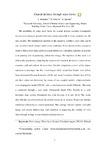Coastal defence through wave farms
| dc.contributor.author | Abanades, J | |
| dc.contributor.author | Greaves, Deborah | |
| dc.contributor.author | Iglesias, Gregorio | |
| dc.date.accessioned | 2016-04-28T14:50:50Z | |
| dc.date.available | 2016-04-28T14:50:50Z | |
| dc.date.issued | 2014 | |
| dc.identifier.issn | 0378-3839 | |
| dc.identifier.issn | 1872-7379 | |
| dc.identifier.uri | http://hdl.handle.net/10026.1/4556 | |
| dc.description | The possibility of using wave farms for coastal defence warrants investigation because wave energy is poised to become a major renewable in many countries over the next decades. The fundamental question in this regard is whether a wave farm can be used to reduce beach erosion under storm conditions. If the answer to this question is positive, then a wave farm can have coastal defence as a subsidiary function, in addition to its primary role of producing carbon-free energy. The objective of this work is to address this question by comparing the response of a beach in the face of a storm in two scenarios: with and without the wave farm. For this comparison a set of ad hoc impact indicators is developed: the bed level impact (BLI), beach face eroded area (FEA), non-dimensional erosion reduction (NER), and mean cumulative eroded area (CEA); and their values are determined by means of two coupled models: a high-resolution wave propagation model (SWAN) and a coastal processes model (XBeach). The study is conducted through a case study: Perranporth Beach (UK). Backed by a well-developed dune system, Perranporth has a bar between − 5 m and − 10 m. The results show that the wave farm reduces the eroded volume by as much as 50% and thus contributes effectively to coastal protection. This synergy between marine renewable energy and coastal defence may well contribute to improving the viability of wave farms through savings in conventional coastal protection. | |
| dc.description.abstract |
The possibility of using wave farms for coastal defence warrants investigation because wave energy is poised to become a major renewable in many countries over the next decades. The fundamental question in this regard is whether a wave farm can be used to reduce beach erosion under storm conditions. If the answer to this question is positive, then a wave farm can have coastal defence as a subsidiary function, in addition to its primary role of producing carbon-free energy. The objective of this work is to address this question by comparing the response of a beach in the face of a storm in two scenarios: with and without the wave farm. For this comparison a set of ad hoc impact indicators is developed: the bed level impact (BLI), beach face eroded area (FEA), non-dimensional erosion reduction (NER), and mean cumulative eroded area (CEA); and their values are determined by means of two coupled models: a high-resolution wave propagation model (SWAN) and a coastal processes model (XBeach). The study is conducted through a case study: Perranporth Beach (UK). Backed by a well-developed dune system, Perranporth has a bar between − 5 m and − 10 m. The results show that the wave farm reduces the eroded volume by as much as 50% and thus contributes effectively to coastal protection. This synergy between marine renewable energy and coastal defence may well contribute to improving the viability of wave farms through savings in conventional coastal protection. | |
| dc.format.extent | 299-307 | |
| dc.format.medium | 0 | |
| dc.language | en | |
| dc.language.iso | en | |
| dc.publisher | Elsevier BV | |
| dc.subject | Wave energy Wave farm Erosion Nearshore impact SWAN XBeach | |
| dc.title | Coastal defence through wave farms | |
| dc.type | journal-article | |
| dc.type | JOUR | |
| plymouth.author-url | http://www.sciencedirect.com/science/article/pii/S0378383914001306 | |
| plymouth.volume | 91 | |
| plymouth.publication-status | Published | |
| plymouth.journal | Coastal Engineering | |
| dc.identifier.doi | 10.1016/j.coastaleng.2014.06.009 | |
| plymouth.organisational-group | /Plymouth | |
| plymouth.organisational-group | /Plymouth/Faculty of Science and Engineering | |
| plymouth.organisational-group | /Plymouth/Faculty of Science and Engineering/School of Engineering, Computing and Mathematics | |
| plymouth.organisational-group | /Plymouth/PRIMaRE Publications | |
| plymouth.organisational-group | /Plymouth/REF 2021 Researchers by UoA | |
| plymouth.organisational-group | /Plymouth/REF 2021 Researchers by UoA/UoA12 Engineering | |
| plymouth.organisational-group | /Plymouth/Research Groups | |
| plymouth.organisational-group | /Plymouth/Research Groups/Marine Institute | |
| plymouth.organisational-group | /Plymouth/Users by role | |
| plymouth.organisational-group | /Plymouth/Users by role/Academics | |
| plymouth.organisational-group | /Plymouth/Users by role/Researchers in ResearchFish submission | |
| dc.rights.embargodate | 2014-07-01 | |
| dc.identifier.eissn | 1872-7379 | |
| dc.rights.embargoperiod | 6 months | |
| rioxxterms.versionofrecord | 10.1016/j.coastaleng.2014.06.009 | |
| rioxxterms.licenseref.uri | http://www.rioxx.net/licenses/under-embargo-all-rights-reserved | |
| rioxxterms.type | Journal Article/Review |


